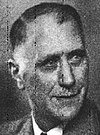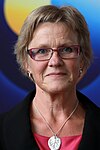Communications (transport) |
| Portrait | Ministers of Communications (Transport)
(Born-Died) | Term | Political party | Coalition | Cabinet |
|---|
| Took office | Left office | Duration |
|---|
| 1 | | Carl Svensson
(1879–1938) | 1 July 1920 | 27 October 1920 | 118 days | Social Democrats | S/SAP | Branting I |
| 2 | | Walter Murray
(1871–1957) | 27 October 1920 | 13 October 1921 | 351 days | Independent | Caretaker | De Geer d.y.
von Sydow |
| 3 | | Anders Örne
(1881–1956) | 13 October 1921 | 19 April 1923 | 1 year, 188 days | Social Democrats | S/SAP | Branting II |
| 4 | | Sven Lübeck
(1877–1941) | 19 April 1923 | 18 October 1924 | 1 year, 182 days | Electoral League | National Party | Trygger |
| 5 | | Viktor Larsson
(1869–1950) | 18 October 1924 | 7 June 1926 | 1 year, 232 days | Social Democrats | S/SAP | Branting III
Sandler |
| 6 | | Carl Meurling
(1876–1963) | 7 June 1926 | 2 October 1928 | 2 years, 117 days | Independent | Free-minded–L | Ekman I |
| 7 | | Theodor Borell
(1869–1944) | 2 October 1928 | 7 June 1930 | 1 year, 248 days | Electoral League | Electoral League | Lindman II |
| 8 | | Ola Jeppsson
(1887–1941) | 7 June 1930 | 24 September 1932 | 2 years, 109 days | Free-minded People's | Free-minded | Ekman II
Hamrin |
| 9 | | Henning Leo
(1885–1953) | 24 September 1932 | 19 June 1936 | 3 years, 269 days | Social Democrats | S/SAP | Hansson I |
| 10 | | Arthur Heiding
(1883–1973) | 19 June 1936 | 28 September 1936 | 101 days | Centre | C | Pehrsson-Bramstorp |
| 11 | | Albert Forslund
(1881–1954) | 28 September 1936 | 16 December 1938 | 2 years, 79 days | Social Democrats | S/SAP–C | Hansson II |
| 12 | | Gerhard Strindlund
(1890–1957) | 16 December 1938 | 13 December 1939 | 362 days | Centre | S/SAP–C | Hansson II |
| 13 | | Gustaf Andersson
(1884–1961) | 13 December 1939 | 30 September 1944 | 4 years, 292 days | Liberals | S/SAP–C–M–L | Hansson III |
| 14 | | Fritiof Domö
(1889–1961) | 30 September 1944 | 31 July 1945 | 304 days | Moderate | S/SAP–C–M–L | Hansson III |
| 15 | | Torsten Nilsson
(1905–1997) | 31 July 1945 | 1 October 1951 | 6 years, 62 days | Social Democrats | S/SAP | Hansson IV
Erlander I |
| 16 | | Sven Andersson
(1910–1987) | 1 October 1951 | 22 March 1957 | 5 years, 172 days | Social Democrats | S/SAP–C | Erlander II |
| 17 | | Sture Henriksson
(1917–1957) | 22 March 1957 | 22 April 1957 † | 31 days | Social Democrats | S/SAP–C | Erlander II |
| 18 | | Gösta Skoglund
(1903–1988) | 26 April 1957 | 25 November 1965 | 8 years, 217 days | Social Democrats | S/SAP–C
(BF left in October 1957) | Erlander II
Erlander III |
| 19 | | Olof Palme
(1927–1986) | 25 November 1965 | 28 September 1967 | 1 year, 307 days | Social Democrats | S/SAP | Erlander III |
| 20 | | Svante Lundkvist
(1919–1991) | 29 September 1967 | 30 June 1969 | 1 year, 275 days | Social Democrats | S/SAP | Erlander III |
| 21 | | Bengt Norling
(1925–2002) | 1 July 1969 | 8 October 1976 | 7 years, 100 days | Social Democrats | S/SAP | Erlander III
Palme I |
| 22 | | Bo Turesson
(1914–1997) | 8 October 1976 | 18 October 1978 | 2 years, 10 days | Moderate | C–M–L | Fälldin I |
| 23 | | Anitha Bondestam
(born 1941) | 18 October 1978 | 12 October 1979 | 359 days | Liberals | L | Ullsten |
| 24 | | Ulf Adelsohn
(born 1941) | 12 October 1979 | 5 May 1981 | 1 year, 205 days | Moderate | C–M–L | Fälldin II |
| – | | Olof Johansson
(born 1937)
Acting | 5 May 1981 | 22 May 1981 | 17 days | Centre | C–M–L | Fälldin II |
| 25 | | Claes Elmstedt
(1928–2018) | 22 May 1981 | 8 October 1982 | 1 year, 139 days | Centre | C–L | Fälldin III |
| 26 | | Curt Boström
(1926–2014) | 8 October 1982 | 30 June 1985 | 2 years, 265 days | Social Democrats | S/SAP | Palme II |
| 27 | | Roine Carlsson
(1937–2020) | 1 July 1985 | 17 October 1985 | 108 days | Social Democrats | S/SAP | Palme II |
| 28 | | Sven Hulterström
(born 1938) | 18 October 1985 | 29 January 1989 | 3 years, 104 days | Social Democrats | S/SAP | Palme II
Carlsson I |
| 29 | | Georg Andersson
(born 1936) | 30 January 1989 | 4 October 1991 | 2 years, 248 days | Social Democrats | S/SAP | Carlsson I
Carlsson II |
| 30 | | Mats Odell
(born 1947) | 4 October 1991 | 7 October 1994 | 3 years, 3 days | Christian Democrats | M–C–L–KD | Bildt |
| 31 | | Ines Uusman
(born 1948) | 7 October 1994 | 7 October 1998 | 4 years, 0 days | Social Democrats | S/SAP | Carlsson III
Persson |
| 32 | | Björn Rosengren
(born 1942) | 7 October 1998 | 31 December 1998 | 85 days | Social Democrats | S/SAP | Persson |
|
| Portrait | Minister for Infrastructure
(Born-Died) | Term | Political Party | Coalition | Cabinet |
|---|
| Took office | Left office | Duration |
|---|
| 1 | | Björn Rosengren
(born 1942) | 1 January 1999 | 16 October 2000 | 1 year, 289 days | Social Democrats | S/SAP | Persson |
| 2 | | Ulrica Messing
(born 1968) | 16 October 2000 | 6 October 2006 | 5 years, 355 days | Social Democrats | S/SAP | Persson |
| 3 | | Åsa Torstensson
(born 1958) | 6 October 2006 | 5 October 2010 | 3 years, 364 days | Centre | M–C–L–KD | Reinfeldt |
| 4 | | Catharina Elmsäter-Svärd
(born 1965) | 5 October 2010 | 3 October 2014 | 3 years, 363 days | Moderate | M–C–L–KD | Reinfeldt |
| 5 | | Anna Johansson
(born 1971) | 3 October 2014 | 27 July 2017 | 2 years, 297 days | Social Democrats | S/SAP–MP | Löfven I |
| 6 | | Tomas Eneroth
(born 1966) | 27 July 2017 | 18 October 2022 | 5 years, 83 days | Social Democrats | S/SAP–MP | Löfven I
Löfven II |
| 7 | | Andreas Carlson
(born 1987) | 18 October 2022 | Incumbent | 2 years, 164 days | Christian Democrats | M–KD–L | Kristersson Cabinet |





























